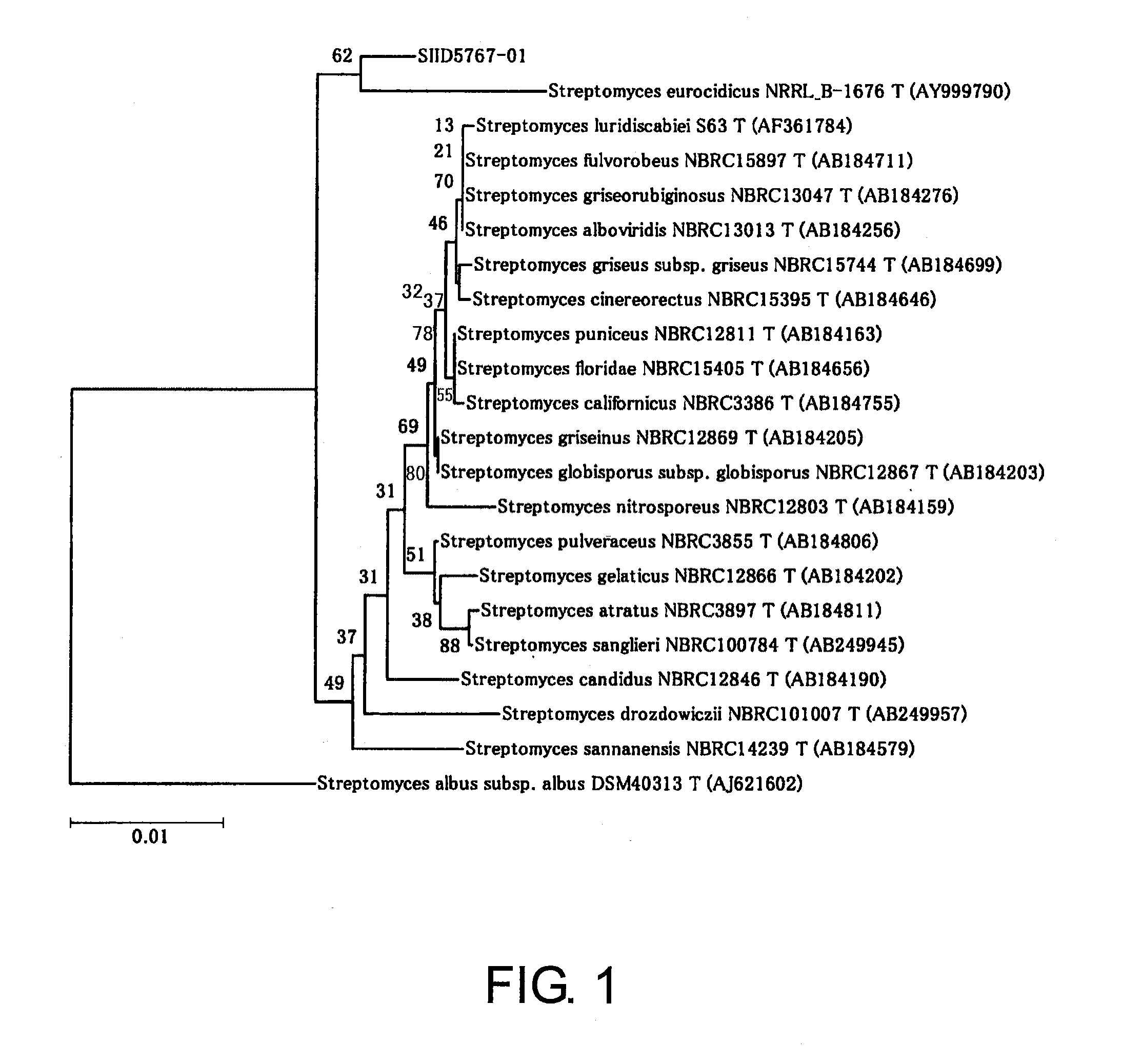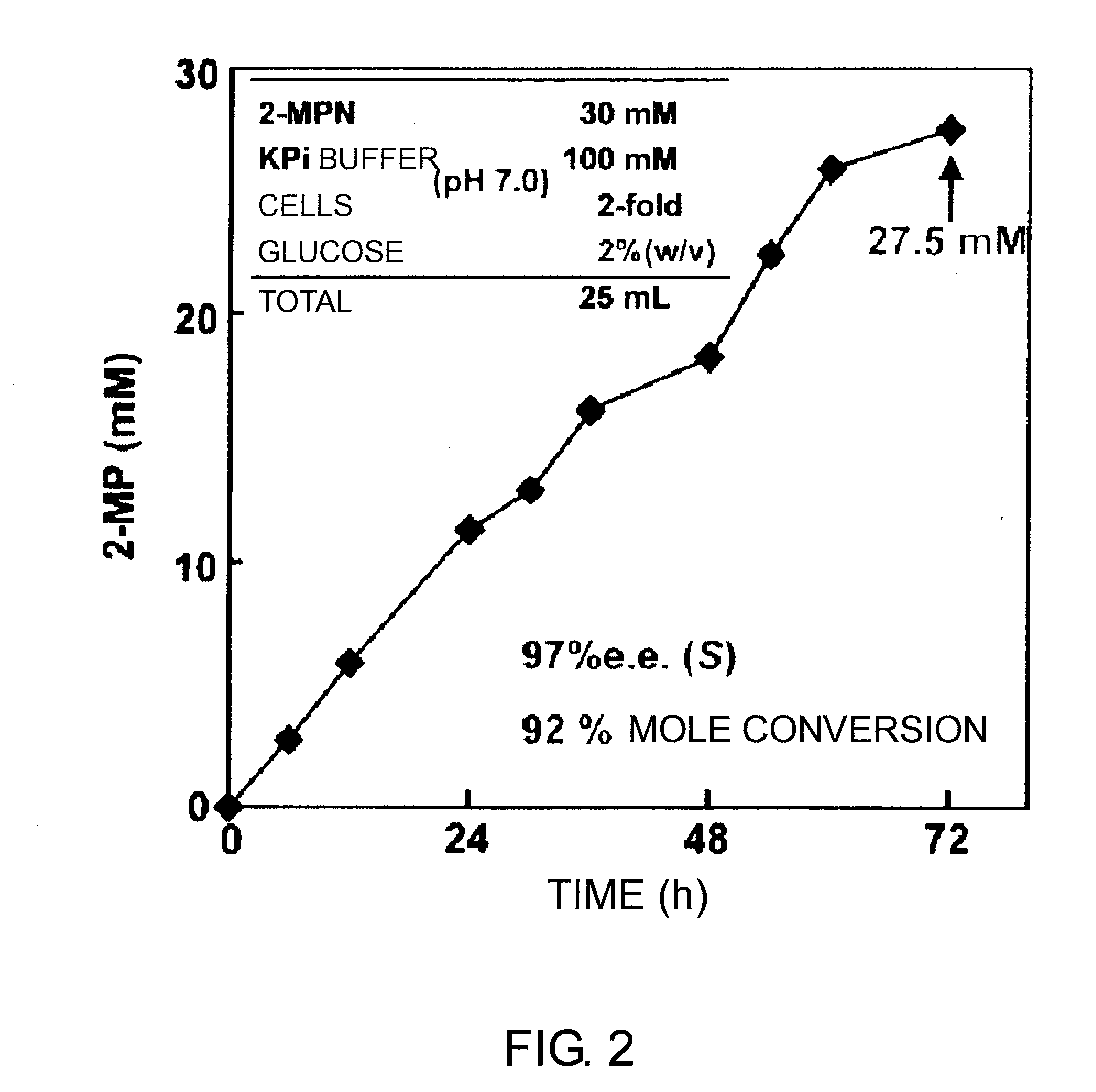Process for production of optically active amine derivative
a technology of optical active amine and derivative, which is applied in the direction of organic chemistry, microorganisms, enzymes, etc., can solve the problems of unclear stereoselectivity of the reaction, inconvenient industrial application, and inefficient /i>, and achieves high stereoselectivity, reduces the ability of microorganisms, and produces efficient optical active amine isomers
- Summary
- Abstract
- Description
- Claims
- Application Information
AI Technical Summary
Benefits of technology
Problems solved by technology
Method used
Image
Examples
example 1
Screening
[0305]Liquid culture medium (pH was adjusted at 7.3) containing 4 g / l yeast extract, 10 g / l malt extract, 4 g / l glucose, 5 mg / l ferric sulfate heptahydrate, and 1 g / l 2-methyl-1-pyrroline was prepared and aliquoted (4 ml) into 18 mm diameter test tubes. The tubes were sterilized by heating at 121° C. for 15 minutes in an autoclave. Bacterial strains shown in Table 1 below were each inoculated to the tubes with a platinum loop. The tubes were incubated at 28° C. while shaking for two to six days.
[0306]The resulting culture media were centrifuged to collect the microbial cells. 25 mM phosphate buffer (pH 7.0) containing 10 mM 2-methyl-1-pyrroline was added to the cells. The cells were reacted at 25° C. while shaking for 24 hours. After the reaction, the cells were removed by centrifugation. Then, TLC analysis was carried out using silica gel (developing solvent: 1-butanol / acetic acid / water=2 / 1 / 1), followed by detection using ninhydrin spray.
[0307]As for the cells under reacti...
example 2
Identification of GF3546
[0309]The microbiological features of GF3546 are summarized in Table 2.
TABLE 2S11D5767-011. MACROSCOPIC OBSERVATIONGROWING CONDITIONS FOR EACH MEDIUMCULTURE AT 30° C. FOR 3 DAYS OR MOREISP2COLONY SIZEφ 2.0-3.0 mmCOLONY SURFACE SHAPECOTTON SHAPEDCOLONY COLOR:SURFACE (AERIAL HYPHA)GRAYREAR SURFACE (BASAL HYPHA)YELLOWWATER-SOLUBLE PIGMENT PRODUCTIONBROWN WATER-SOLUBLE PIGMENT PRODUCEDISP3SURFACE: GRAY REAR SURFACE: BROWNISP4SURFACE: WHITE REAR SURFACE: PALE YELLOWISP5SURFACE: PALE YELLOW REAR SURFACE: PALE YELLOW2. MICROSCOPIC OBSERVATIONSHAPE OF AERIAL HYPHABRANCHEDWIDTH 0.9-1.0 mmHELICAL AERIAL MYCELIUM OBSERVED3. PHYSIOLOGICAL AND BIOCHEMICAL PROPERTIESGELATIN LIQUEFACTION+STARCH HYDROLYSIS+NITRATE-REDUCING REACTION−PEPTONZATION / COAGULATION OF SKIM MILK−RANGE OF GROWING TEMPERATURE (° C.)20+25+30+37+45−SALT TOLERANCE (%) 4.0− 7.0−10.0−13.0−CARBON SOURCE AVAILABILITYISP MEDIUM No. 9−GLUCOSE+L-RHAMNOSE+wD-MANNITOL+D-FRUCTOSE+L-ARABINOSE+wRAFFINOSE−SUCROSE−D-XY...
example 3
Synthesis of (S)-2-methylpyrrolidine by GF3546
[0315]Liquid culture medium (pH was adjusted at 7.3) containing 20 g / l yeast extract, 30 g / l meat extract, 10 g / l NZ amine, 20 g / l glucose, 1 mg / l ferric sulfate heptahydrate, 1 mg / l manganese chloride tetrahydrate, and 1 mg / l zinc sulfate heptahydrate was aliquoted (40 ml) into shaking flasks. The flasks were sterilized by heating at 121° C. for 15 minutes in an autoclave. Streptomyces sp. GF3546 was inoculated to the flasks with a platinum loop. The flasks were incubated at 28° C. while shaking for 72 hours.
[0316]The resulting culture media were filtrated to collect the microbial cells. 30 mM 2-methyl-1-pyrroline and 100 mM phosphate buffer containing 2% glucose (pH 7.0) were added to the cells. The cells were reacted at 25° C. while shaking.
[0317]After reaction, derivatization with GITC was carried out appropriately according to Example 1. Then, the product was analyzed by HPLC. The result is shown in FIG. 2. The result showed that (S...
PUM
| Property | Measurement | Unit |
|---|---|---|
| Fraction | aaaaa | aaaaa |
| Acidity | aaaaa | aaaaa |
| Mass | aaaaa | aaaaa |
Abstract
Description
Claims
Application Information
 Login to View More
Login to View More - R&D Engineer
- R&D Manager
- IP Professional
- Industry Leading Data Capabilities
- Powerful AI technology
- Patent DNA Extraction
Browse by: Latest US Patents, China's latest patents, Technical Efficacy Thesaurus, Application Domain, Technology Topic, Popular Technical Reports.
© 2024 PatSnap. All rights reserved.Legal|Privacy policy|Modern Slavery Act Transparency Statement|Sitemap|About US| Contact US: help@patsnap.com










